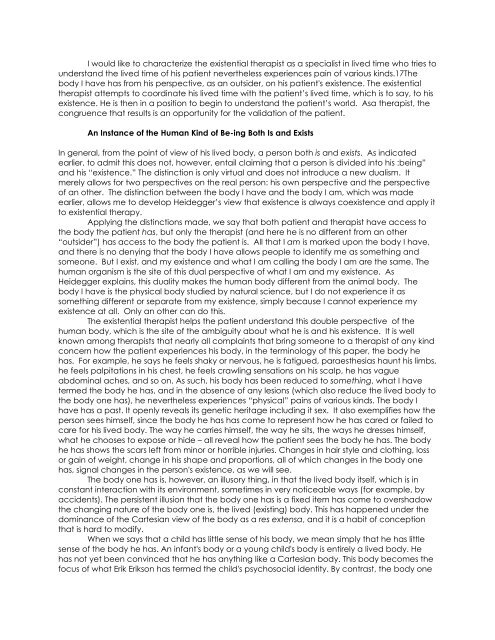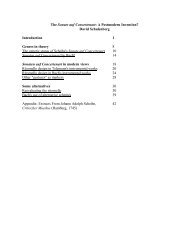SEVEN PAPERS ON EXISTENTIAL ANALYSIS ... - Wagner College
SEVEN PAPERS ON EXISTENTIAL ANALYSIS ... - Wagner College
SEVEN PAPERS ON EXISTENTIAL ANALYSIS ... - Wagner College
Create successful ePaper yourself
Turn your PDF publications into a flip-book with our unique Google optimized e-Paper software.
I would like to characterize the existential therapist as a specialist in lived time who tries to<br />
understand the lived time of his patient nevertheless experiences pain of various kinds.17The<br />
body I have has from his perspective, as an outsider, on his patient's existence. The existential<br />
therapist attempts to coordinate his lived time with the patient’s lived time, which is to say, to his<br />
existence. He is then in a position to begin to understand the patient’s world. Asa therapist, the<br />
congruence that results is an opportunity for the validation of the patient.<br />
An Instance of the Human Kind of Be-ing Both Is and Exists<br />
In general, from the point of view of his lived body, a person both is and exists. As indicated<br />
earlier, to admit this does not, however, entail claiming that a person is divided into his :being”<br />
and his “existence.” The distinction is only virtual and does not introduce a new dualism. It<br />
merely allows for two perspectives on the real person: his own perspective and the perspective<br />
of an other. The distinction between the body I have and the body I am, which was made<br />
earlier, allows me to develop Heidegger’s view that existence is always coexistence and apply it<br />
to existential therapy.<br />
Applying the distinctions made, we say that both patient and therapist have access to<br />
the body the patient has, but only the therapist (and here he is no different from an other<br />
“outsider”) has access to the body the patient is. All that I am is marked upon the body I have,<br />
and there is no denying that the body I have allows people to identify me as something and<br />
someone. But I exist, and my existence and what I am calling the body I am are the same. The<br />
human organism is the site of this dual perspective of what I am and my existence. As<br />
Heidegger explains, this duality makes the human body different from the animal body. The<br />
body I have is the physical body studied by natural science, but I do not experience it as<br />
something different or separate from my existence, simply because I cannot experience my<br />
existence at all. Only an other can do this.<br />
The existential therapist helps the patient understand this double perspective of the<br />
human body, which is the site of the ambiguity about what he is and his existence. It is well<br />
known among therapists that nearly all complaints that bring someone to a therapist of any kind<br />
concern how the patient experiences his body, in the terminology of this paper, the body he<br />
has. For example, he says he feels shaky or nervous, he is fatigued, paraesthesias haunt his limbs,<br />
he feels palpitations in his chest, he feels crawling sensations on his scalp, he has vague<br />
abdominal aches, and so on. As such, his body has been reduced to something, what I have<br />
termed the body he has, and in the absence of any lesions (which also reduce the lived body to<br />
the body one has), he nevertheless experiences “physical” pains of various kinds. The body I<br />
have has a past. It openly reveals its genetic heritage including it sex. It also exemplifies how the<br />
person sees himself, since the body he has has come to represent how he has cared or failed to<br />
care for his lived body. The way he carries himself, the way he sits, the ways he dresses himself,<br />
what he chooses to expose or hide – all reveal how the patient sees the body he has. The body<br />
he has shows the scars left from minor or horrible injuries. Changes in hair style and clothing, loss<br />
or gain of weight, change in his shape and proportions, all of which changes in the body one<br />
has, signal changes in the person's existence, as we will see.<br />
The body one has is, however, an illusory thing, in that the lived body itself, which is in<br />
constant interaction with its environment, sometimes in very noticeable ways (for example, by<br />
accidents). The persistent illusion that the body one has is a fixed item has come to overshadow<br />
the changing nature of the body one is, the lived (existing) body. This has happened under the<br />
dominance of the Cartesian view of the body as a res extensa, and it is a habit of conception<br />
that is hard to modify.<br />
When we says that a child has little sense of his body, we mean simply that he has little<br />
sense of the body he has. An infant's body or a young child's body is entirely a lived body. He<br />
has not yet been convinced that he has anything like a Cartesian body. This body becomes the<br />
focus of what Erik Erikson has termed the child's psychosocial identity. By contrast, the body one















